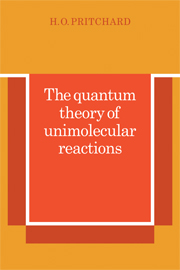Book contents
- Frontmatter
- Contents
- Preface
- Acknowledgements
- 1 The observed properties of thermal unimolecular reactions
- 2 The master equation for internal relaxation in molecules
- 3 Reaction as a perturbation of the internal relaxation
- 4 The specific rate function k(E) as an inverse Laplace transform
- 5 Unimolecular fall-off in strong collision systems
- 6 A molecular dynamic approach to specific rate functions
- 7 Building in the randomisation processes
- 8 Weak collision processes
- 9 How well does it all work?
- Appendix 1 Units, symbols, and errata
- Appendix 2 Rate constants for the thermal isomerisation of cyclopropane and for the thermal decomposition of cyclobutane
- Appendix 3 Computer programs for thermal unimolecular reactions
- Exercises
- References
- Author index
- Subject index
7 - Building in the randomisation processes
Published online by Cambridge University Press: 04 August 2010
- Frontmatter
- Contents
- Preface
- Acknowledgements
- 1 The observed properties of thermal unimolecular reactions
- 2 The master equation for internal relaxation in molecules
- 3 Reaction as a perturbation of the internal relaxation
- 4 The specific rate function k(E) as an inverse Laplace transform
- 5 Unimolecular fall-off in strong collision systems
- 6 A molecular dynamic approach to specific rate functions
- 7 Building in the randomisation processes
- 8 Weak collision processes
- 9 How well does it all work?
- Appendix 1 Units, symbols, and errata
- Appendix 2 Rate constants for the thermal isomerisation of cyclopropane and for the thermal decomposition of cyclobutane
- Appendix 3 Computer programs for thermal unimolecular reactions
- Exercises
- References
- Author index
- Subject index
Summary
The general perception, all these years, of the course of a unimolecular reaction has been that the reactant molecule receives the requisite amount of energy by collision, but that it can only react to form products after a time delay during which it has to rearrange that energy and reassemble it into some more appropriate fashion. This reorganisation of the internal energy has almost always been regarded as an intramolecular process [30. R], with a rate which is independent of all external conditions; except for this, the nature of the reorganisation process has been rather poorly defined. Broadly speaking, older treatments of the problem tend to visualise the molecule comprising two domains, one where the energy is collected from external sources by collision, and the other where it is needed to bring about the reaction, with a time delay for communication of internal energy between the two. On the other hand, many modern treatments use the language of radiationless processes: as such, they tend to be unnecessarily complicated from the point of view of treating bulk unimolecular reactions, and they also tend to neglect other possible causes which could have the same end result. The treatment given below is an elaboration of one which I have evolved [80.P2] and which I believe is helpful in clarifying the nature of the unimolecular reaction process.
- Type
- Chapter
- Information
- The Quantum Theory of Unimolecular Reactions , pp. 79 - 100Publisher: Cambridge University PressPrint publication year: 1984



